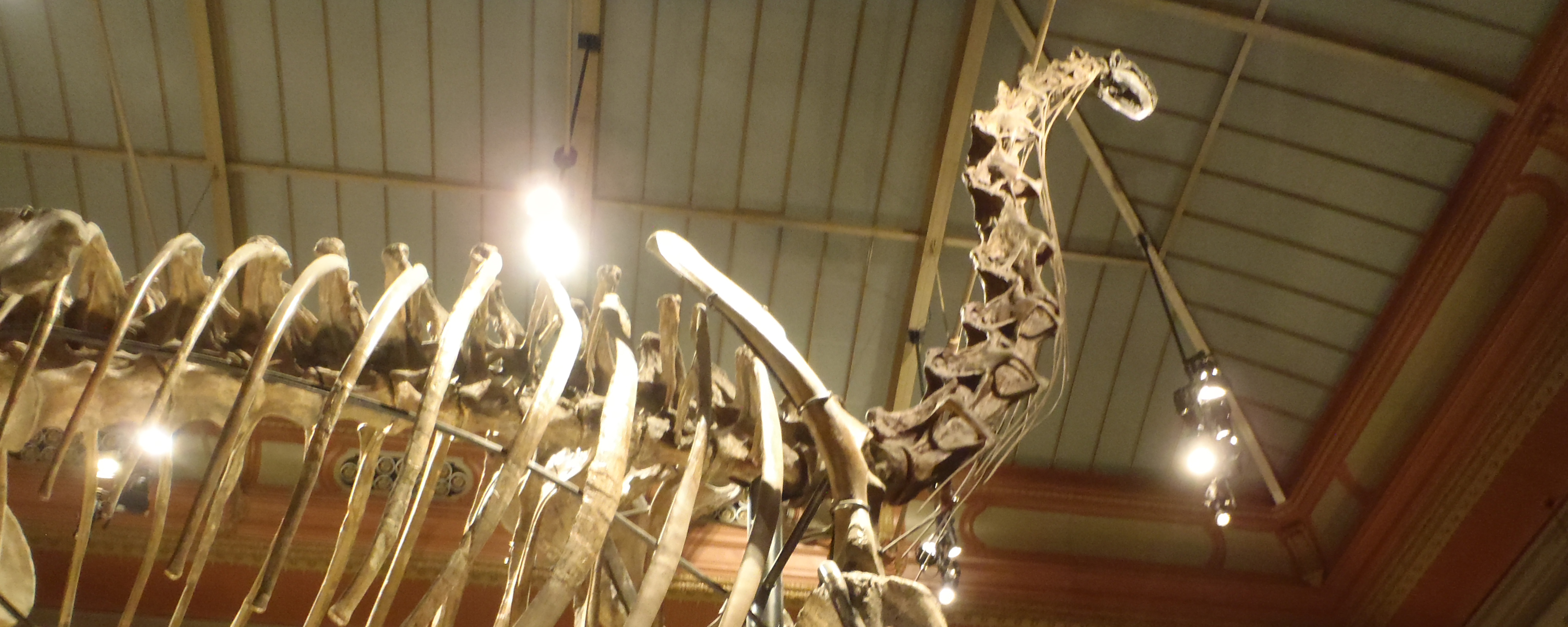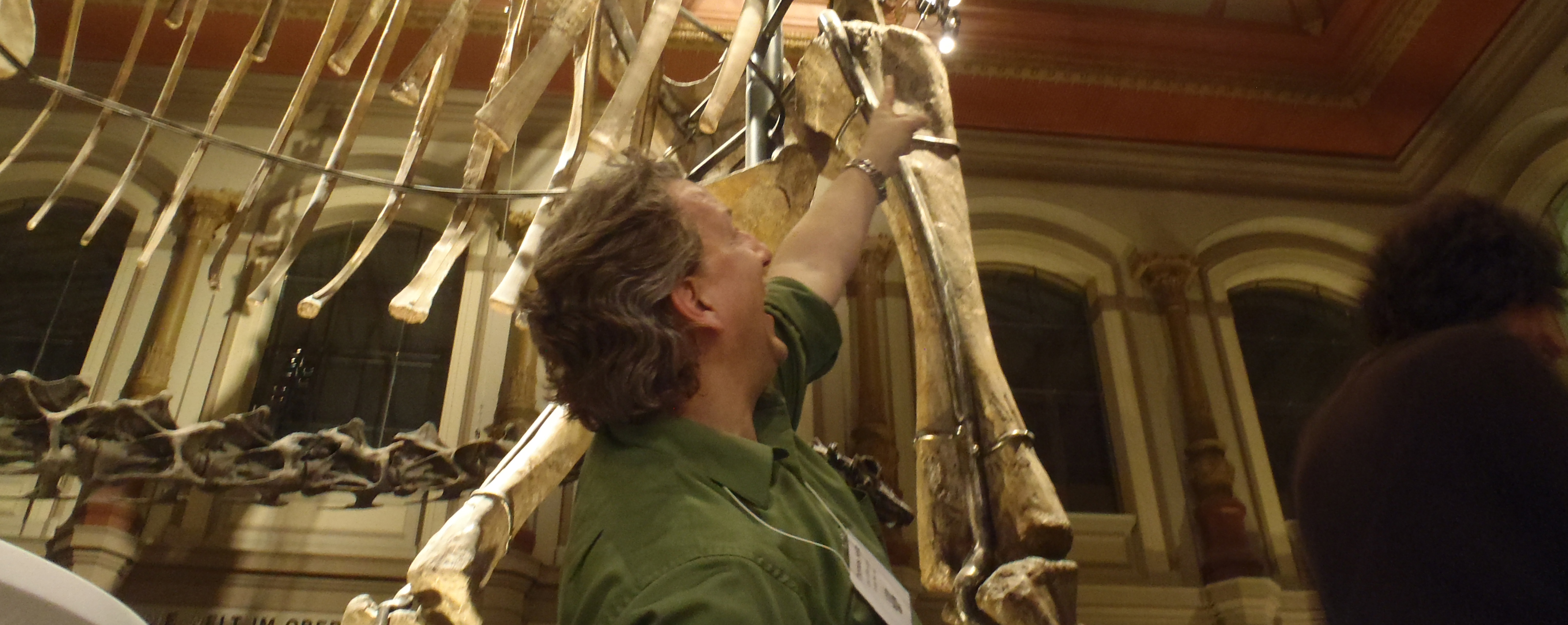


Key Points:
•While not all dinosaurs were giants, all major branches of Dinosauria (Thyreophora, Ornithopoda, Marginocephalia, Sauropodomorpha, Theropoda) produced taxa equal to or exceeding in size the largest land animals of the modern word. In the case of Sauropoda, these included the largest animals to ever live on land.
•Some factors may have been necessary but were not sufficient to explain this giant size: parasaggital limb posture; efficient hearts & lungs; etc.
•Like placental large mammal communities, the food chains were very short for dinosaurian communities: hence more energy was available for the large predators and prey.
•One very important relevant difference is that dinosaurs--being egg-layers--did not have the limitations on gestation length and litter side that would restrict placentals from reaching their size.
•Another factor has to do with the joints of archosaurs vs. mammals; in archosaurs the amount of articular cartilage does not decrease in proportion as body size grows, meaning that it can continue to cushion the joints better than the decreasing-sized cartilage of mammals.
Calculating dinosaur size is a bit tougher that it might sound. The first issue is "what do you mean by size?" Do you mean "length" or "height" (i.e., linear dimensions)? Few dinosaur skeletons are complete enough and in the original position (giving the spacing of the intervertebral discs, so that the actual length is preserved) to give 100% fidelity of these linear dimensions. But in general it isn't TOO bad, particularly for taxa with complete necks and tails. And for those that are not complete, we can extrapolate total body length of an individual based on the parts that are known (with the caveats that the less-complete the fossil is, and/or the farther it is related from good specimens, the greater the error bars of the extrapolation.)
Dinosaurs include the longest vertebrate animals of all time, longer even than the biggest whales. (They are NOT the longest animals, though: that is the astonishingly-long ribbon worm Lineus longissimus, at 55 m (180 ft)!!!)
But consider that most of the length in dinosaurs is tail and neck, regions of the body that are (relatively speaking) slender. For instance, at 3 m (10') long Coelophysis sounds like it is bigger than humans, but half of the length of the dinosaur is tail, and about 2/5 of the rest is neck.
Thus, mass is the more important metric of size for an animal is most cases. It is a good estimate of how much animal is actually there: how much muscle, how much lung, ultimately how many cells. So how can we estimate dinosaur mass? We can do it the way you might do with a modern animal: i.e., get it onto a scale. (Alternatively, weigh yourself; weigh yourself holding your pet; and subtracting the former from the latter.) How can we estimate dinosaur body mass?
There are two major methods: volumetric models and linear regressions. Volumetric models involve creating a 3D model of the dinosaur (old style, a real physical model; today, a computer graphic). This should be based on as complete a fossil as possible. In the most complex models, the fraction of the body made up of bone, muscle, guts, fat, skin, and open space (inside the guts, lungs, and air sacs) is calculated, and each is multiplied by the observed density of these tissues in modern animals. (In simpler versions, some "average" density of archosaur is multiplied by the volume.) Of course, the actual amount of the soft tissues isn't known for these fossils, and indeed might vary widely between the fat and lean seasons. Additionally, the vast majority of dinosaur fossils are too incomplete to serve as the sources for accurate 3D models. Finally, this is a rather time-intensive approach, as such models could potentially be fairly complex.
An alternative is to use some form of linear measurement (lengths or circumferences of a bone or bones), used in a calculation to yield an estimated mass. Considerable work in measurements of modern animals has found that the smallest circumference of the femur (or femur and humerus, for quadrupeds) scales mathematically fairly closely to body size in modern tetrapods. An allometric equation of linear measurements vs. body size can be calculated, and then used for estimating body mass in fossil animals by plugging in the preserved bone dimensions. This has the advantage of not requiring the complete skeleton (although obviously requiring at least these bones to be discovered!)
Size is a property of individuals, not taxa: One important point to remember with both these approaches (and indeed any other) is that taxa do not have masses!! By this I mean that, for instance, there is no "mass" for Tyrannosaurus rex. Instead, any given individual of T. rex had its own mass, and this needs to be estimated on a case by case basis. Think of it this way: what is the mass of Homo sapiens? It can obviously vary a lot: an NFL linesman is going to mass much more than a ballerina. So bear this in mind when considering what we mean by the size of a given dinosaur species.
Regardless of the approaches used, there is going to be some uncertainty in our estimates; after all, they are scientific calculations. And in fact slight differences of approaches might yield wildly different results. For instance, different methods used for the specimen of Tyrannosaurus rex nicknamed "Sue" (the most complete, and one of the largest, individuals known) vary from a mere 4 tonnes to a maximum of 18 tonnes!!
It isn't just that some dinosaurs were large. It is that giant (>1 t) size is fairly common in dinosaur groups, and that >5 t size occurs in both carnivorous and ornithischian dinosaurs (with many independent cases), and that >10 t is actually a STANDARD body size for the sauropod dinosaurs! Indeed, the very largest dinosaurs reached masses of 80-100 t (or, in other words, the mass of a herds of elephants!). In contrast, where there have been a few 10 t land mammals, most mammals were much smaller. (Of course, even dinosaurs were dwarfed by the modern blue whale). So how did dinosaurs get so big?
There are lots of unsupported, less-than-reasonable, pseudoscientific explanations:
So, let's take a look at other possibilities.
Was It Limb Posture (i.e., the Parasagittal Stance)? It is true that all the supergiant land animals (dinosaurs, elephants, deinotheres, indricothere rhinos, etc.) all have an upright stance. While there are giant 10-15 t crocodilians contemporaneous with and after the Age of Dinosaurs, these semi-upright animals were primarily aquatic and in a sense don't count.
But other groups with parasagittal stance--such as most pseudosuchians, marsupial mammals, modern birds, etc.--never reach these sizes. So it might be that a parasagittal stance is necessary but not sufficient for the >10 t size.
Was It From a REEAALLLLYYYYY LOOOOONNNNNGGGGG Period of Growth? Giant tortoises and big modern crocodilians live a very long time (centuries in the case of tortoises), growing throughout their life. Perhaps dinosaurs just grew for a tremendously long time? But as we saw previously, dinosaurs had a rapid growth rate and relatively short life spans.
So we can REJECT the idea that a long growth phase led to giant dinosaur size!
Very Efficient Dinosaur Hearts and Lungs? Yes, they had both, as we will see. These were probably a necessity for giantism, but not sufficient.
Was it Exceedingly Short Food Chains? When we watch nature specials on TV that focus on large charismatic modern land mammals, we get the impression that the simple food chain of plant → large herbivore → large carnivore (e.g., grass → zebra → lion) is typical. In fact, while it does apply to the world of Cenozoic hoofed mammals and their predators, it actually is not the case for most terrestrial life. As in the marine realm, most terrestrial food chains have many steps from primary productivity to apex carnivore, often through insects and other herbivorous invertebrates, to carnivorous arthropods, to small-bodied insectivorous animals, to predators of those, and so on. (For example, plants → aphids → ants → spiders or mantids → small insectivorous birds → snakes → hawks). And of course there is loss of energy every step up the food pyramid.
Ecosystems of protomammal synapsids of the Carboniferous, Permian, and Triassic, and perhaps even protocroc pseudosuchians of the Triassic, seem to have had relatively few large bodied herbivores, and may have had these longer, energy-leaking food chains. And thus, there is less energy available towards the tops. In contrast, dinosaurs produced a broad variety of herbivores able to capture the energy at the base of the pyramid, with a set of carnivores feeding on these. These short food chains may have allowed much more of the solar energy to make its way into meat.
Of course, there is still the observation that even mega-mammals with similarly short food chains fail to achieve dinosaurian size, so this cannot be the entire story. However, it is worth noting that said mega-mammals are the ONLY other case of terrestrial vertebrates which get anywhere near dinosaurian size.
Was it Changing Atmospheres? Even as dinosaurs were evolving, the atmosphere they were breathing was evolving, too. Geochemists have seen that the ratios of various gases, including oxygen, have varied over geologic time. At least some models suggest that the Middle Jurassic though the end of the Cretaceous had oxygen levels exceeding the present 20%. This would mean that every breath a dinosaur took would have more oxygen, making it easier to power a high metabolism.
Furthermore, experiments of growing some plants of Mesozoic varieties under Mesozoic-style atmospheres suggests that their productivity (essentially, the amount of nutrients they produce per area per unit time) could go up 2 to 3 times present day conditions. If so, then there would have been more food available per unit area for the herbivores (and from this up the energy pyramid), again making it easier to be an endotherm in these conditions. (On the other hand, some plants do more poorly under the higher carbon dioxide situations.)
Environmental changes in Mesozoic discussed above may have supported giantism:
The second aspect is probably easier to deal with. There are several possible advantages:
However, we may be asking the wrong question. The problem might not be "how did dinosaurs get so big?"; it might be "why DON'T placental mammals get so big?" This may in part be due to the lower oxygen level and productivity during the Cenozoic. However, it may have to do with mammalian vs. dinosaurian reproduction:
In contrast, even giant dinosaurs could could lay clutches of a couple dozen eggs a year or more. Thus, they could survive environmental change much more easily than big mammals. So mammals may not be able to reach giant size because they become extremely vulnerable to extinction.
Additionally, the thicker cartilage of dinosaurs was present at all body sizes, whereas the size of the articular cartilage in mammals decreases with increasing body size. As a result, larger mammals have less cushioned joints, which may have been a hinderance to activity. So it may simply be that larger land mammals could not actually move effectively, but that dinosaurs continued to be mobile.
And another:
To Next Lecture.
To Previous Lecture.
To Lecture Schedule.
